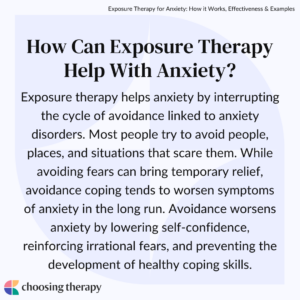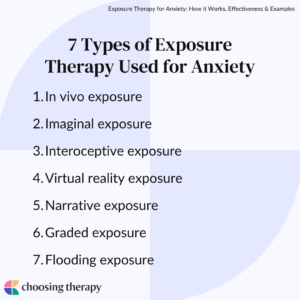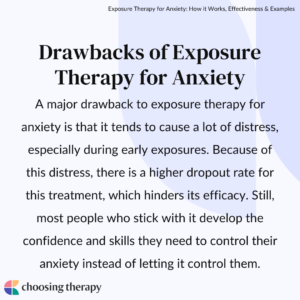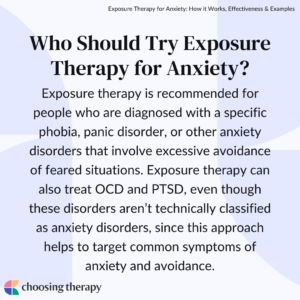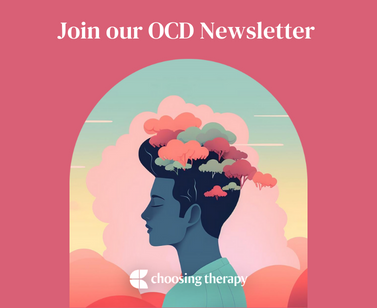Exposure therapy for anxiety involves gradually confronting feared objects or situations to lessen the associated anxiety over time. By facing their anxiety in a controlled environment, exposure therapy helps people develop the skills and confidence to manage their anxiety without relying on avoidance to cope.1,2 The length of treatment varies, but some people see improvements after just a few sessions.
Do I have OCD?
The first step to getting help is an accurate clinical assessment and diagnosis. NOCD’s therapists will provide a comprehensive assessment of your experience. If they find that you do not meet the criteria for OCD, they will still help assist you in identifying what you may be experiencing. Get Started With A Free 15 Minute Call
What Is Exposure Therapy?
Exposure therapy is a treatment that uses systematic desensitization to help people gradually face and overcome their fears. Exposure therapy was developed as a specialized type of cognitive behavioral therapy (CBT) used to help people with anxiety disorders lessen their avoidance of feared situations. Instead, people in exposure therapy are taught other, healthier coping skills like relaxation techniques and mindfulness.1
In exposure therapy, people gradually expose themselves to situations that they normally avoid because it distresses them. These ‘exposures’ happen in a controlled and gradual manner, according to an individualized treatment plan that outlines a step-by-step process to face fears, starting with the smaller ones and working up slowly. These exposures can be planned to happen in real life (called an in-vivo exposure) or by imagining the feared situation, looking at a picture, or using virtual reality exposures.1,3
How Can Exposure Therapy Help With Anxiety?
Exposure therapy helps anxiety by interrupting the cycle of avoidance linked to anxiety disorders.1 Most people try to avoid people, places, and situations that scare them. Most people try to avoid people, places, and situations that scare them. While avoiding fears can bring temporary relief, avoidance coping tends to worsen symptoms of anxiety in the long run. Avoidance worsens anxiety by lowering self-confidence, reinforcing irrational fears, and preventing the development of healthy coping skills.2
When avoidance becomes a primary method of dealing with anxiety, it tends to spread to other areas of life in ways that interfere with a person’s routine, relationships, ability to function, and quality of life. For some people with specific phobias or panic disorder, avoidance becomes so severe that it prevents people from working, interacting with other people, or sometimes even leaving home.4 Exposure therapy is the most effective treatment for people in this situation.2,5
Types of anxiety exposure therapy can help with include:1,5,6
- Phobias: Exposure therapy is one of the most effective treatments for specific phobias, which are disorders where the person’s anxiety is centered around a specific object or situation (i.e., spiders, flying, heights, etc.). Exposure techniques are effective for overcoming phobias because they help target and reduce avoidance behaviors, which are almost always a feature of these disorders.
- Social anxiety: Social anxiety disorder is a condition where a person’s anxiety centers around the fear of being embarrassed, rejected, or criticized by other people. Exposure therapy can help with social anxiety by teaching people different skills to help them navigate social interactions rather than relying on withdrawal and social avoidance.
- Panic disorder: People with panic disorder have recurrent panic attacks and an intense fear of future attacks that leads to extreme avoidance of any triggers or situations that might cause anxiety. Exposure therapy can help people with panic disorder gradually reduce this avoidance while also equipping them with relaxation techniques that can help them lessen anxiety.
- Post-traumatic Stress Disorder (PTSD): People with PTSD often rely on avoidance of people, places, and situations that remind them of the trauma they experienced. When this avoidance is causing distress or preventing them from being able to function, exposure therapy techniques can be helpful in reducing these symptoms.
- Obsessive-compulsive disorder (OCD): A specific kind of exposure therapy called exposure and response prevention (ERP) is highly effective in treating the symptoms of OCD. This form of exposure therapy for OCD teaches a person how to experience upsetting thoughts and urges without using compulsive OCD rituals to cope.
7 Types of Exposure Therapy Used for Anxiety
There are a few different types of exposure therapy that may be more effective in treating various kinds of anxiety-related avoidance. All types of exposure therapy use the same basic framework of gradually facing fears to become desensitized to them and utilizing relaxation exercises for anxiety instead of avoidance.1 The main differences between different types of exposure therapies involve how and when the exposures take place.
Here are seven types of exposure therapy used to treat anxiety:1
1. In Vivo Exposure
In vivo exposures are done in real-life situations where a person encounters something that scares them. For example, an in vivo exposure for someone with a phobia of public speaking could involve raising their hand in training to answer a question in front of a small group. Once this has been mastered, the person might work up to bigger in vivo exposures like standing and giving a toast at a friend’s wedding or offering to lead a training at work. In this way, in vivo exposures help gradually desensitize someone to feared situations.1
Because in vivo exposures involve facing fears in person, it’s not always possible for them to occur during a therapy session. When it isn’t possible, in vivo exposures may be assigned as therapy homework between sessions. The therapist might ask the client to track how the exposure went by keeping a log and rating their level of anxiety at different points during the exposure. Depending on how the exposure went, the person may be asked to repeat it until it is no longer triggering anxiety before moving on to the next exposure.
2. Imaginal Exposure
Not all fears and phobias are possible to recreate in an in vivo exposure therapy, which is why imaginal exposures are sometimes used instead. While an in vivo exposure involves an in-person encounter with something scary, an imaginal exposure does not. Imaginal exposures involve simulating a feared situation by asking a person to visualize or imagine it. Pictures, videos, or other props are sometimes used in imaginal exposures to help the person create a mental image or scenario involving their fear.1
Examples of imaginal exposures include showing pictures of spiders to someone with arachnophobia or asking them to describe in detail a scary memory of a past spider encounter. By doing so, the person’s anxiety will spike in similar ways as it would during an in vivo exposure, which triggers the process of systematic desensitization. After they have completed these imaginal exposures, they may graduate to in vivo exposures or more vivid and intense imaginal exposures like watching a close-up video of a poisonous spider.
3. Interoceptive Exposure
Interoceptive exposures involve intentionally causing a feared physiological reaction in the body. This kind of exposure therapy is most useful for treating people who experience a lot of somatic symptoms of anxiety that worry or concern them. When these physiological symptoms become a primary source of anxiety for a person, interoceptive exposure therapy might be recommended. It’s common for anxious people to fixate on the sensations in their bodies in ways that worsen their anxiety and lead to panic.1,4,6
One common example of this is a person who rushes to the ER because they confuse a panic attack with a heart attack. Interoceptive exposures can help people learn not to overreact when their heart rate or blood pressure rises.3,6 In session, they might be asked to do cardio exercises to become desensitized to these normal bodily functions. They may also be taught skills to help them refocus on sensations in other, more neutral areas of their body, like their fingers or toes, in order to help them calm down faster.
4. Virtual Reality Exposure
Virtual reality exposure therapy involves the use of VR headsets and technology to simulate a realistic experience of a situation someone fears and avoids.1 As virtual reality technology has improved and become more lifelike, a number of studies have shown that this method can be just as effective as in vivo exposures for symptoms of anxiety.7 VR exposures are also helpful when using exposure therapy to treat phobias that are too expensive, complicated, or inaccessible to encounter in real life.
One example of virtual reality exposure for anxiety is using VR headsets with flight simulations to help people overcome a fear of flying. The VR headsets can create realistic flight sights and sounds that make a person feel as though they’re on a plane and can even enhance the experience by adding turbulence, storms, or other adverse flying conditions. In this way, it’s possible for someone to start with short, simple flight simulations and gradually work their way up to longer and more intense simulations.
Treatment For OCD NOCD: Online OCD Treatment Covered By Insurance – Regain your life from OCD. Do live video sessions with a licensed therapist specialized in treating OCD. Treatment from NOCD is covered by most major insurance plans. Learn how you can use your insurance benefits. Visit NOCD Talkiatry: Is OCD Medication Right For You? Speak with A Doctor – Talkiatry can match you with a psychiatrist who takes your insurance and is accepting new patients. They’re in-network with major insurers and offer medication management with supportive therapy. Free Assessment
5. Narrative Exposure
Narrative exposure therapy (NET) is an exposure therapy technique that asks people to use words to describe an experience that scares them. Narrative exposures can involve asking someone to describe a hypothetical situation or one they actually experienced in the past. Narrative exposures can be written down, said aloud, or both. Often, this type of exposure therapy involves retelling the story a number of times to help the person become desensitized to parts of it that are particularly painful, uncomfortable, or distressing to talk about.1
A narrative exposure approach is sometimes used in the treatment of PTSD.5 For example, someone who experienced abuse in childhood may be asked to create a trauma narrative that describes the abuse and re-read this several times in session until the story no longer triggers as much anxiety or distress. Sometimes, family members or other supports are asked to attend a session where the person reads their trauma narrative aloud.
6. Graded Exposure
Graded exposure is another term for ‘gradual exposure’, which involves the deliberately gradual pacing of treatment. To assist in creating a gradual plan for overcoming fears, therapists using graded exposures often ask clients to develop a rating scale for their anxiety. Next, the client is asked to use this scale to rate how anxious different situations would make them, and a plan is created to gradually confront their fears, starting small and working up.3
This individualized plan is sometimes called an ‘exposure hierarchy’ or ‘fear ladder’, and progress in treatment is marked by moving up to the top.1 An example of a graded exposure plan for social anxiety might start with making small talk with a classmate and move up to asking a classmate to hang out or attending an on-campus meet-up. At the top of the hierarchy is the person’s biggest fear, which might be going on a date with someone from a dating app or hosting a holiday party in your home.
7. Flooding Exposure
Most forms of exposure therapy are gradual in nature, but flooding therapy is the exception to this rule. In flooding therapy, a person confronts their biggest fears first rather than starting small and working up gradually.1 The main advantage of flooding therapy is that because it progresses faster, it can accelerate the rate of treatment progress and symptom improvement. Still, most therapists recommend gradual desensitization over flooding tactics since they’re gentler and just as effective.
Flooding therapy can involve in vivo exposures, imaginal exposures, narrative exposures, virtual reality exposures, or a combination of these. An example of a flooding approach for contamination OCD would be a person who tries to overcome a germ phobia by forcing themselves to eat food off the floor. It’s likely that this would cause the person to experience a panic attack, but they would be instructed to continue it until their anxiety subsides.3,6
Does Exposure Therapy Effectively Treat Anxiety?
Exposure therapy is one of several effective therapies for symptoms of anxiety. It is mainly recommended for the treatment of panic disorder, phobias, PTSD, and OCD, which all feature a lot of avoidance behaviors.1,3 People who have a lot of anxiety but don’t avoid things might not benefit as much.
Exposure therapy is also only helpful to people who are able to identify specific triggers for their anxiety. Someone who can’t pinpoint what’s causing their anxiety won’t be able to create effective exposure scenarios since they don’t know what they need to be desensitized to.3 This is why exposure therapy is not typically recommended for people struggling with generalized anxiety disorder (GAD) unless they are able to identify specific anxiety triggers.
How Quickly Does Exposure Therapy for Anxiety Work?
How quickly exposure therapy works depends a lot on the type of exposure therapy being used, the severity of the person’s anxiety, the extent of their avoidance, and how quickly the desensitization process occurs. Because there are so many variables involved in the process, it’s impossible to predict with absolute certainty how quickly someone will see improvements.
Some people see significant improvements or even remission of anxiety symptoms in just a few sessions, and some need to remain in treatment for a few months before seeing progress. Exposure therapy can also be combined with other treatments like medication or traditional forms of talk therapy, which can help boost the efficacy of treatment for some people.1,5,9
Drawbacks of Exposure Therapy for Anxiety
A major drawback to exposure therapy for anxiety is that it tends to cause a lot of distress, especially during early exposures. Because of this distress, there is a higher dropout rate for this treatment, which hinders its efficacy.8 Still, most people who stick with it develop the confidence and skills they need to control their anxiety instead of letting it control them.
Who Should Try Exposure Therapy for Anxiety?
Exposure therapy is recommended for people who are diagnosed with a specific phobia, panic disorder, or other anxiety disorders that involve excessive avoidance of feared situations.1,5 Exposure therapy can also treat OCD and PTSD, even though these disorders aren’t technically classified as anxiety disorders, since this approach helps to target common symptoms of anxiety and avoidance.6,9
When Is Exposure Therapy Not Recommended?
Exposure therapy isn’t recommended for people with anxiety who are not able to identify specific triggers for their anxiety. Exposure therapy is also not recommended for people who don’t rely on excessive avoidance to cope, as the therapy works by reducing avoidance and triggering desensitization.3,9 People who have extreme anxiety, dissociative episodes, or high-risk conditions like heart disease should consult with their medical provider before entering into exposure therapy.8
OCD & OCPD Treatment Find a therapist specialized in treating OCPD and OCD. NOCD provides online treatment for OCD and many co-occurring conditions. NOCD is covered by most major insurance plans. Start With A Free 15 Minute Call
What to Expect During Exposure Therapy Sessions
During an exposure therapy session, you can expect to be given a lot of detailed information about the process before starting to do any exposures. Normally, the first appointment is dedicated to doing an intake assessment, which involves answering questions and providing information to confirm your diagnosis. At the end of this appointment, your provider will likely discuss your diagnosis with you and make recommendations for treatments that could help.
If you decide to move forward with exposure therapy, you can expect to spend time during the next appointment making a plan to begin the process of exposure. Depending on the specific type of exposure therapy you’re receiving, this may involve making an exposure hierarchy that maps out a plan to overcome your fears, starting with the smaller ones and working up. After this, your provider will teach you different coping skills for anxiety to prepare you for your first exposure, which may happen in or outside of the therapy session.1,3,6,9
This process continues throughout the duration of your treatment, and the therapist may make slight adjustments to your exposures based on how they go and the progress you’re making. The exact length of treatment varies, but some people are able to overcome a phobia or fear in just one, two, or three exposure sessions. For more complicated scenarios, the length of treatment can extend to several months, especially if the therapist feels it’s appropriate to move more slowly through exposures.9,10
How to Find an Exposure Therapy Therapist for Anxiety
Finding a therapist who specializes in exposure therapy usually isn’t difficult, as many therapists are trained in this approach. The best place to start your search is often online, where you can use an online therapist directory to narrow your results by location, insurance, and areas of specialization. Alternatively, an online therapy platform can provide therapists who offer exposure therapy online, where it’s possible to do this treatment from the comfort of your own home.
Other Treatment Options for Anxiety
For people with anxiety who don’t think exposure therapy is right for them, a number of good alternatives exist. Other treatments for anxiety include other therapies, medication, or a combination of both.5,9,10 Some people have success with natural approaches and at-home treatments like meditation, mindfulness, biofeedback, and relaxation techniques like yoga or breathwork for anxiety.
Here are some of the other effective treatments for anxiety:1,5,6,9,10
- Cognitive behavioral therapy (CBT): CBT for anxiety is considered a frontline treatment for anxiety because there are so many studies that prove it’s effective. People who aren’t interested in exposure therapy still might benefit from learning other CBT skills like how to interrupt worried thoughts, improve self-care, and be more assertive.
- Medication: Anti-anxiety medications are sometimes recommended in addition to therapy to help people reduce the physiological symptoms of anxiety and/or balance brain chemistry. Common anxiety medications include SSRIs, benzodiazepines, and beta-blockers for anxiety. These might be prescribed regularly or on an as-needed basis during times when people have high anxiety.
- Acceptance and commitment therapy (ACT): ACT for anxiety teaches people how to use mindfulness approaches for anxiety to observe unhelpful thoughts and experience difficult emotions. ACT therapy teaches people to act on their core values instead of acting on their emotions or impulses. This treatment can be used for anxiety disorders as well as for symptoms of OCD.
- Mindfulness-based stress reduction (MBSR): MBSR is a mindfulness-based approach that can help people struggling with anxiety, chronic pain, and stress. Mindfulness-based stress reduction can help people learn how to observe distressing or uncomfortable thoughts and feelings without getting overly involved in them.
- Applied relaxation: Applied relaxation is a therapy approach that is often used to treat panic disorder and involves learning relaxation skills like progressive muscle relaxation for early symptoms of anxiety. This can help people learn how to de-escalate anxiety and even stop panic attacks.
To help our readers take the next step in their mental health journey, Choosing Therapy has partnered with leaders in mental health and wellness. Choosing Therapy is compensated for marketing by the companies included below. OCD Therapy NOCD: Effective, Affordable, & Convenient OCD Therapy Do live, face-to-face video sessions with a therapist who specializes in treating OCD and get 24/7 support between sessions. NOCD is covered by many insurance plans and is available nationwide. Visit NOCD Virtual Psychiatry Talkiatry Get help from a real doctor who takes your insurance. Talkiatry offers medication management and online visits with expert psychiatrists. Take the online assessment and have your first appointment in days. Free Assessment OCD Community - Free To Join! Join others who are overcoming OCD. Participate anonymously. Find support, connect, and overcome challenges with us. The community is managed by NOCD. Join The Community OCD Newsletter A free newsletter from Choosing Therapy for those impacted by OCD. Get helpful tips and the latest information. Sign-UpAdditional Resources
In My Experience
What to know when finding a therapist for OCD With so much information out there regarding providers and treatment options for obsessive compulsive disorder, it can be hard to know exactly where to start—especially when you have to consider everything from the type of provider to the different treatment methods, as well as how you’ll fit it into your busy schedule. Can OCD make it hard to make decisions? From choosing what to wear in the morning to picking what to eat for dinner, decision-making is a part of everyone’s daily routine. But for millions of people with Obsessive-Compulsive Disorder (OCD), making any choice can feel like a daunting, sometimes impossible task.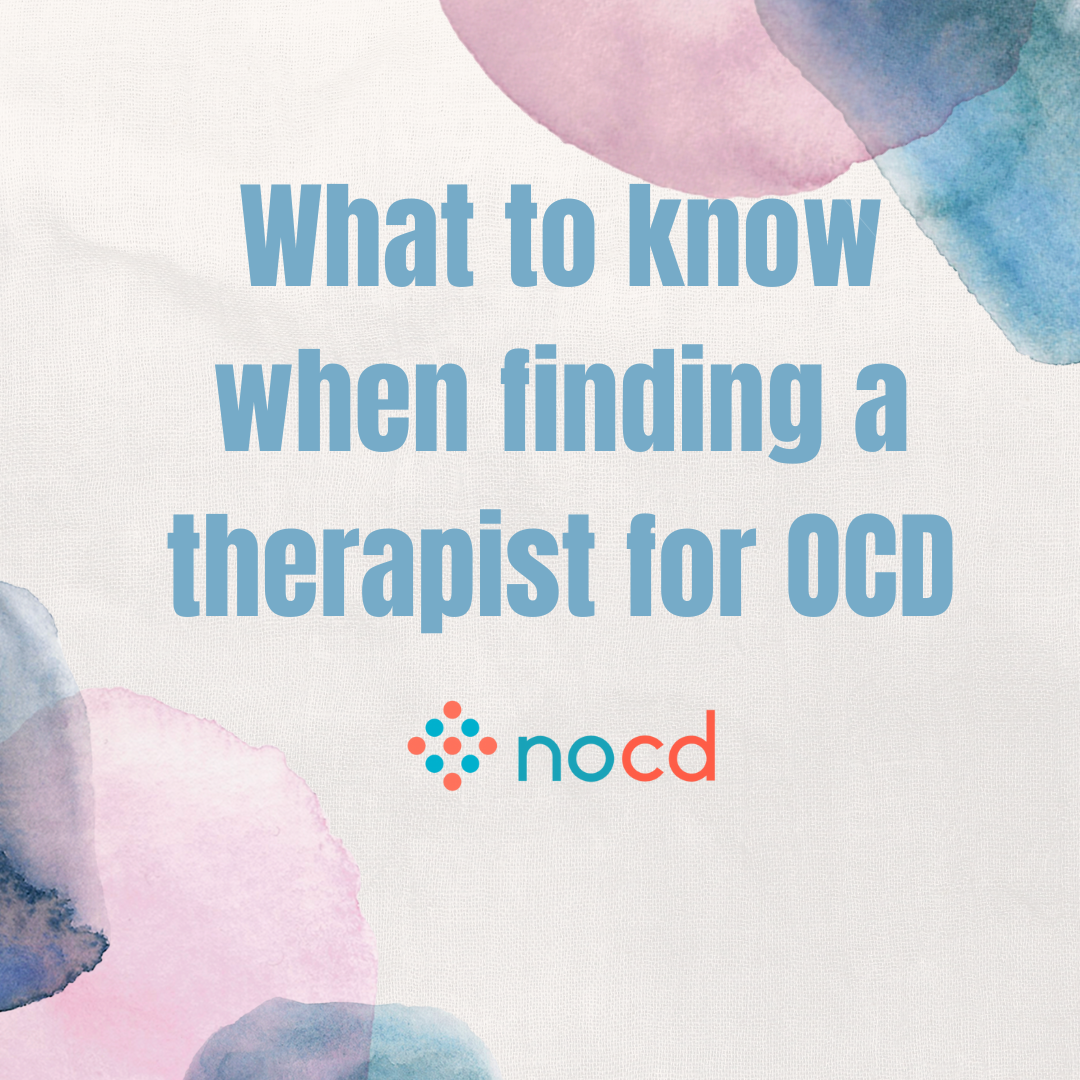
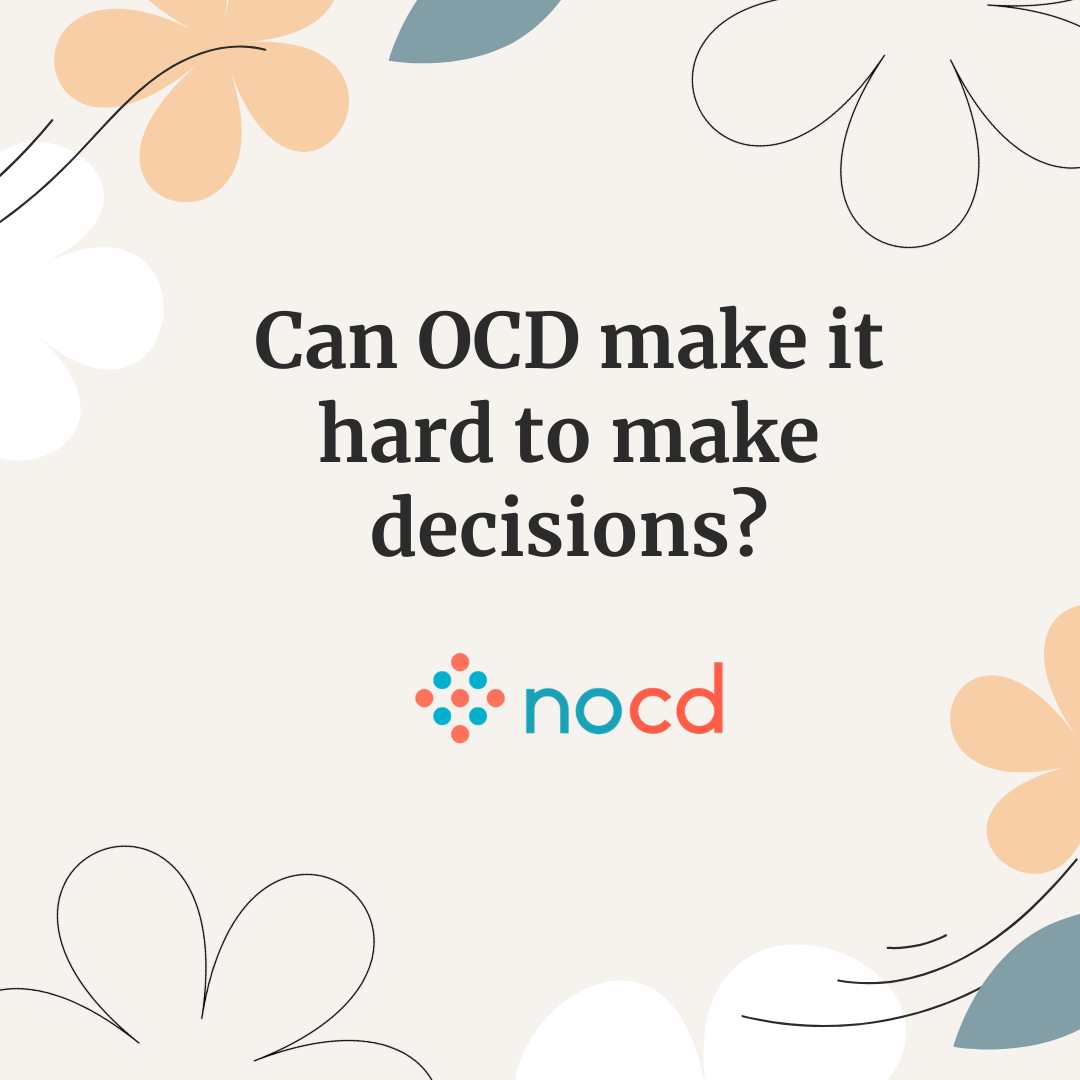
Exposure Therapy for Anxiety Infographics
